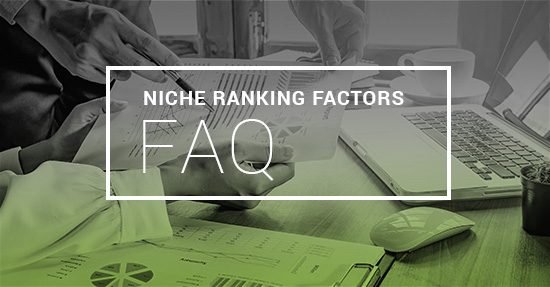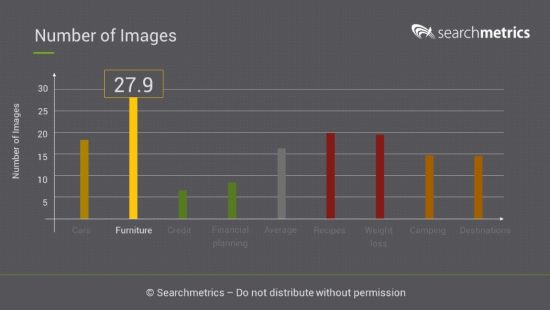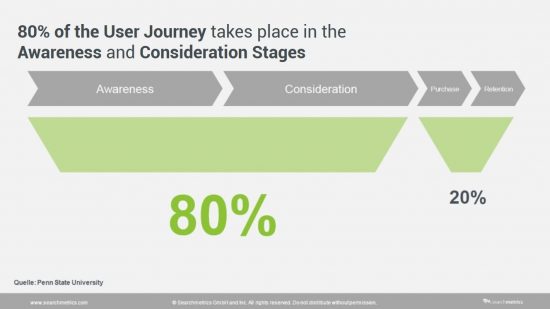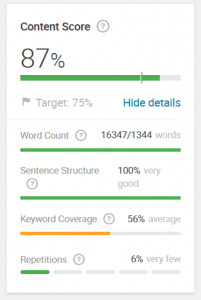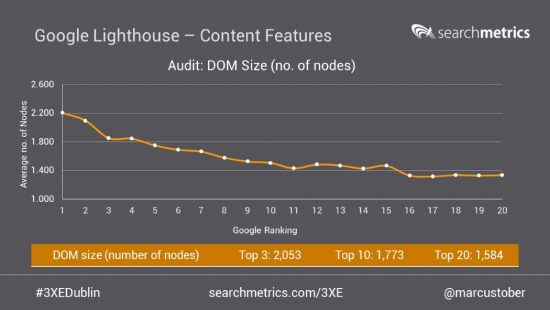This year, we’ve been talking a lot about niche ranking factors, with Searchmetrics Founder, Marcus Tober, holding talks at numerous SEO conferences, and our whitepaper in October examining in detail this new way of analyzing Google ranking data by focusing on specific topical niches. Following on from our webinar, “Into the Niche and Beyond”, this post answers some of the questions we’re most often asked when we talk about the topic of niche ranking factors.
Webinar Recording: Into the Niche and Beyond
If you didn’t manage to take part in our recent webinar with Marcus Tober and myself, you can still register to receive the full recording here:
Niche Ranking Factors: Your Questions Answered
In this article, I’ve aimed to answer some of your questions on niche ranking factors, as we couldn’t cover absolutely everything in our paper and webinar. Marcus has been kind enough to help me out with a couple of answers too. The 22 questions cover the following aspects of this topic:
Ranking Factor Definitions
One issue with ranking factor studies is that terminology is not always used consistently throughout the industry. Something like ‘page speed’ could refer to any number of metrics. This is why, in our 2018 ranking factors whitepaper, we have included a succinct definition of each factor measured, in an attempt to remove some of this ambiguity. More clarification is given here.
1. How are you measuring the number of images? 27.9 per page seems like a lot?
Our study of ranking factors for niches found that pages ranking in the top 10 for furniture keywords have an average 27.9 images. This does seem like a lot – and it is! Our data shows that it is higher than the rate found in any other analyzed niche. And this is true even though only images of minimum 200x200px are counted.
The fact is that many pages that rank highly for furniture keywords have extensive image galleries, many of which even contain far more than 28 images. Furniture is an area where customers like to see a wide range of choice – it is no coincidence that real-world furniture shops dedicate vast areas of floorspace to showrooms and mock-up houses, and the online equivalent of this is the use of large galleries with dozens of images.
2. Does the number of internal links (e.g. in your whitepaper) refer to one URL or the whole domain?
As with all of our ranking factors, we are measuring the URLs that rank amongst the top 10 search results for keywords in the given niche. This means that the number of internal links refers to the specific URLs that rank for the relevant keywords, and not for domains as a whole.
3. What does “file size” refer to? Is this compressed or non-compressed? Does this include the size of images?
The definition used in our 2018 whitepaper is: “Measures the size of the HTML in kilobytes (kB). The file size is measured for each URL, yielding an average file size in kilobytes for each niche.” This metric doesn’t include the weight of images, but it is not the only way of measuring the size of a URL. One Google Lighthouse audit looks at the DOM size, counting the number of nodes, while another (has enormous network payloads) gives the byte weight breakdown according to different resources.
As with load times, no one single size metric can be considered more important than all the others. It all depends on the impact on the user experience. As my colleague, Malte Landwehr, has said in the past, you shouldn’t just pick a load time KPI at random to optimize for; you should consider the real-life user and their experience of how the page loads. And the same principle applies to file sizes.
Mobile vs Desktop
Even though the main focus of niche ranking factors is the differentiation between websites operating in different segments, the topic of “mobile vs desktop” remains of interest. Websites in some niches will tend to receive the majority of their traffic from mobile users, while others will have a more desktop-based readership.

4. How important is the mobile sector in niches where customers are unlikely to convert on mobile e.g. because the company sells high-end luxury products?
Clearly, if the majority of your website visitors are using desktop computers, then the mobile version of your page will be less important than for a website that is primarily serving a mobile audience. However, only focusing on your conversion pages can be a mistake, as 80% of the user journey – likely even more for customers looking at expensive purchases – takes place in the awareness and consideration stages of the sales funnel.
This means that, even if users may not be converting on mobile, they may be conducting topic and/or product research, which represents a great opportunity for pages to capture user attention, build brand awareness and gain trust. If you completely neglect your mobile page, then you will be missing out on this kind of traffic for informational searches.
5. Is it worthwhile having a separate mobile page for large pages, with lots of text, images and/or a large HTML document?
Generally speaking, the trend is moving away from separate mobile pages (like m. domains), and towards one page that is responsive and able to provide a quick, comfortable user experience on any device. Speed is a big issue for mobile users (in some niches even more so than in other), and has been confirmed by Google as a mobile ranking factor, but there are numerous ways of optimizing the mobile version of your website, such as using dynamic elements like accordions, without having to create a separate domain.
Furthermore, the (gradual) switchover to mobile-first indexing means that Google is primarily crawling the mobile version of pages. Any additional content on the desktop page may not even be considered when evaluating a page for rankings.
6. How important is mobile-first indexing for a page that is primarily visited by desktop users?
Google’s mobile-first indexing finally started rolling out in March 2018, with a huge wave of sites being switched over in September 2018. Although Google has stated that only sites that are mobile-ready will be switched over, this doesn’t depend directly on where your traffic is coming from. If you have received notification that mobile-first indexing has been enabled, then you need to make sure your mobile site is Googlebot-friendly, even if most of your users are still on desktop.
Another point is that, if your mobile page is not well-optimized, then it will be little wonder that most of your users are coming from desktop, whatever your niche. You might be surprised at how much mobile traffic you could gain by improving the mobile experience on your domain.
7. How relevant is a sticky header for content-heavy mobile pages?
Something as specific and subjective as a sticky header is unlikely to be a direct ranking factor. With all elements like this, you have to think about the user experience. A sticky header gives the reader an easy way to navigate to another page on the domain, wherever they are on your site. This could be considered more important on mobile than desktop due to scrolling being more cumbersome, particularly if you have pages with long reams of text content. Therefore, sticky headers could be an option if you are trying to create a smoother user experience on your mobile site and improve your user signals e.g. by lowering bounce rate.
Optimization Tips and Strategies
Looking at data is one thing, but converting this into applicable optimization strategies is often a whole other challenge.

8. If a domain has several URLs on one topic that seem to be suffering from content cannibalization, would you recommend merging the content onto one URL?
This question refers to the example of the pharma giant, Bayer, which offers seemingly good content around the topic of “headaches”, but splits it across multiple URLs. In our webinar, Marcus highlighted how this causes so-called content cannibalization, resulting in none of the URLs on the topic ranking very well.
And the answer is yes – if you seem to be suffering from cannibalization, then it is a good idea to focus on one URL, put all relevant content there, and no-index the others. Many websites that have followed this strategy have seen it bring a considerable boost in the overall visibility of their domain.
9. Are there advantages, in addition to using structured data, to organizing information like recipe ingredients in a table?
Organizing information, like recipe ingredients, in a table is a useful way of making your content easily digestible (no pun intended) for the user. A reader’s eyes tend to be drawn to anything that isn’t just a block of text, so structured content elements like bullet-point lists and tables are a way of catching their attention and highlighting the most important information.
Of course, something that looks like a table from the user’s perspective doesn’t necessarily have to be an HTML <table>. However, structuring the information in this way makes it clear to crawlers that this is well-organized data, and it increases the chance of the content being picked up and used in a Featured Snippet. Along with lists and paragraphs, tables are the most common form of content that finds its way into Featured Snippets, appearing at position zero above the other search results.
10. Are there any plug-ins or tools you would recommend for optimizing WordPress sites?
Google is currently offering beta access to a WordPress plugin called Site Kit, which would certainly be worth exploring, if you haven’t yet done so. Additionally, my colleague, Svetlana Stanković, recently held a webinar with SEO Consultant Lukasz Zelezny where they discussed, among other topics, the optimization of WordPress sites.
11. Does the Searchmetrics Suite give insight into ranking factors for branches or niches?
Marcus: At the moment you can’t get a complete “ranking factors study” within our Suite. The complexity of the studies and the data cleaning, which takes a lot of time after the data is crawled, currently makes it impossible to provide this.
However, we do have the possibility to run studies in many markets for many niches, even highly individual markets. These studies are tailored to a client’s individual needs and doable within a limited scope. I must emphasize though that you shouldn’t expect this to be part of the Suite very soon, because the manual aspect of each study remains significant.
12. How would you recommend I find out the content ranking factors for my individual niche?
Marcus: Content is something complex and the first thing I would do is to analyze my market and benchmark the results with my own content. Why? This is a clear reality check. Because if you compare yourself against the most successful players, you see where you deviate and what you should potentially look into more deeply.
Most of this is already part of our Content Experience software. We don’t call it “Content Factors” there, but we do look at all the best performing sites for any given topic(s) and aggregate the data. So we have all the content, structure, phrases and text length, which lets you clearly compare your content with how the competition is doing. In the last step, you even get a Content Score where your content is rated based on the overall market. I think this data-driven approach is highly innovative and a good indicator of whether the text is more or less relevant.
13. Is it possible that images are considered more important for furniture pages? Does that mean that Google would accept a potentially longer load time?
This is entirely possible, and precisely what we are saying. Google’s algorithm is advanced enough to understand that some searches, such as those for furniture keywords, are better served by pages that provide a large amount of visual content. Other searches may be better served by text and/or video content.
While adding images to your site is likely to increase load time, furniture pages ranking on page 1 of Google’s search results have a large number of images, meaning that they have found the right balance to best serve the user intent. You shouldn’t forget about load times – you should still optimize your images of course – but neither should you go all-out for a super-lean website if it means leaving out content that users are looking for.
14. Since not all pages can be interlinked from category pages or navigation menus, which tips you recommend to ensure good crawling by internal linking?
Marcus: Internal linking is a huge topic for SEO, and one that a lot of companies get wrong. A common mistake on eCommerce websites is having a link on every single page to every other category – even to ones that are completely unrelated. If you do this, you are diluting the relevance of your links, and failing to guide either crawlers or users to pages that really matter. A better approach is to create a more hierarchical link structure, so that you can link to higher levels of other categories, but you don’t put links to unrelated sub- or sub-sub-categories on every page.
Google Lighthouse
In our webinar, we went a step beyond the topic of niche ranking factors and looked at investigating the relationship between Google’s Lighthouse audits and ranking data.

15. Which Google Lighthouse factors are the most important? Is there a checklist of priorities?
We can’t say just now, as Searchmetrics is yet to conduct a full-scale, comprehensive analysis of Google Lighthouse factors. Our early analyses have, however, found several audits for which high-ranking pages tend to perform better than lower-ranking pages. If you are interested in viewing a selection of results, you can watch Marcus Tober’s presentation held at 3XE Dublin in October.
Beyond that, if using Lighthouse to analyze your own page, you can run audits to see where your page is falling behind what Google considers best practice standards, which may give you ideas for where to optimize. And of course, you can run a Lighthouse audit on your competitors’ pages too, which could reveal opportunities for you to close the gap.
16. How can it be possible that some pages have low scores in Lighthouse’s performance audit and yet still enjoy top rankings?
This is possible because Google considers such a wide range of factors, and emphasizes different aspects of a page in different niches, or depending on the search intent. Therefore, not all top-ranking pages will receive top marks in all audits. For some search terms, the user intent may be better served by bigger pages with more content, rather than pages that are focused on performance. In fact, our early analysis suggests that, overall, high-ranking pages tend to fail the “uses an excessive DOM size” audit more often than lower-ranking pages.
17. Google Lighthouse recommends three particular image formats: WebP, JPEG 2000 and JPEG XR – do you have any advice on this?
These are the image types that Google looks for in its performance audit, “Serve Images in Next-Gen Formats”. So far, our early studies of Google Lighthouse suggest that better-ranking pages do make more frequent use of these next-gen formats. The rate amongst top 3 pages is around 57%, but only 52% when looking at the whole top 20.
More analysis is required, and this trend will not hold in every niche, but this could suggest that Google considers this area important, or could emphasize it more in the future. As with any technological advance, as uptake increases, websites that fail to follow suit are liable to find themselves lagging behind.
18. How is it possible to check all my URLs in one go with Google Lighthouse?
The feature within Google Chrome’s Developer Tools for running Lighthouse audits allows for one audit of one URL, and this normally takes approximately 90 seconds, after which you get a complete report for that URL, or a report on those aspects you have selected. You don’t want to run audits in this way for thousands of pages but picking out a few URLs that are representative of your domain should be able to provide you with insights into how your website is performing in Google’s eyes.
Miscellaneous
Our whitepaper and webinar couldn’t possibly have covered all niches and all conceivable rankings factors. Here are a few questions we received on topics not addressed.

19. Is it possible to rank well in a competitive niche even without any backlinks?
Backlinks are still part of Google’s ranking algorithm, but they no longer carry the weight they used to. Even in 2016, our ranking factor study that year found that backlinks had already lost importance. Again, it depends on your niche. In some niches, such as ones with a high news relevance, it can be easier to gain high-value backlinks than in others. And if your competitors all have strong backlink profiles, and you don’t, then this will likely put you at a disadvantage. High-quality backlinks do remain valuable, but there is no cast-iron rule stating that a page always needs backlinks to rank well.
20. Is off-page SEO still important?
Yes, off-page SEO is still an important topic. The only reason why the current study of niche ranking factors focused on on-page factors was that these were considered more suitable for highlighting and showcasing contrasts between pages in different niches.
21. Is WDF*IDF still a relevant topic?
WDF*IDF – as a formula for measuring the relevance of a piece of content – operates at keyword level. While this has not been debunked, it has been superseded by more advanced methods of measuring content relevance. These use vector modelling techniques (such as Word2vec) to analyze the relationships between different terms and/or natural language processing (NLP) to measure the quality of texts.
Marcus: A method that combines Word2Vec and TF*IDF is part of our Content Experience and can be used out of the box. This is not a promotion of our software; it should just underline that leveraging the power of data is serious and something we have been engaging with at Searchmetrics for many years.
22. What about my Niche?
Our whitepaper included data on eight niches, which were selected in an attempt to ensure variety, to provide insights that would be, at least in part, representative of other niches, and to correspond to sectors relevant to our current client base.
Understandably, if you (or your clients) aren’t operating in one of our eight niches, you’ll be more interested in ranking factor data more relevant to your business. We’ve had people asking about niches from gardening and NGOs to the service sector and B2B enterprises. Although we can’t promise that every niche will be covered, we do plan to expand our analyses in 2019 (and beyond), so stay tuned for updates. And always feel free to get in touch to let us know what interests you so that we can focus our research on meeting your needs.

